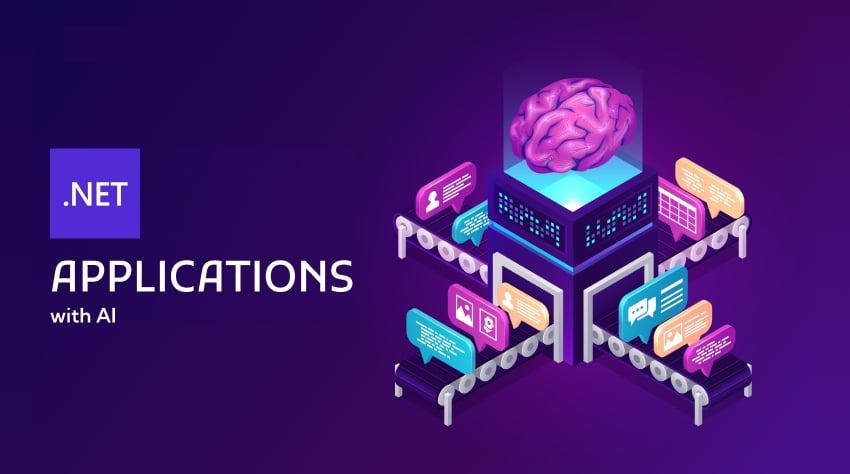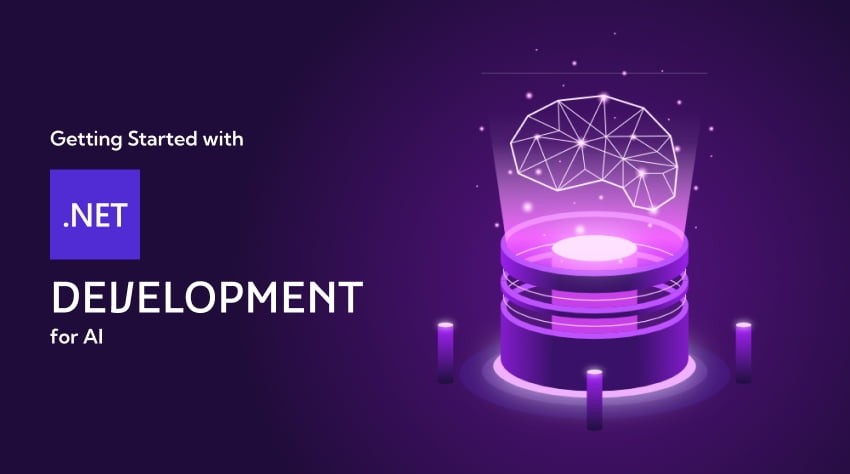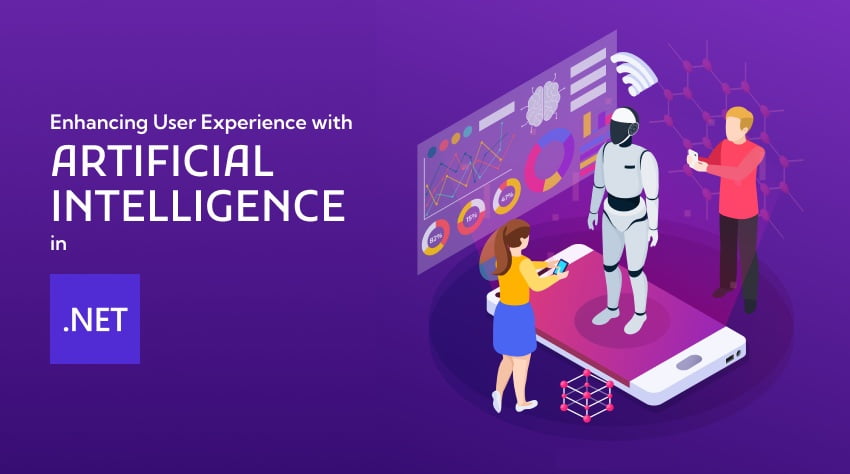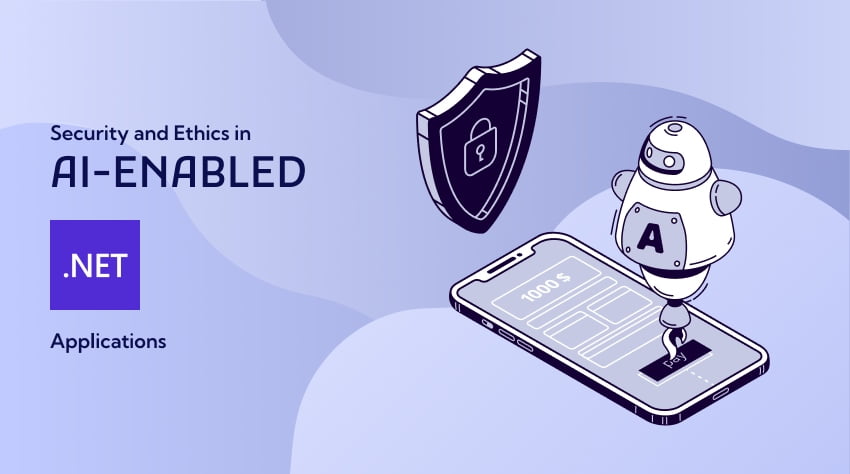Last Updated on –
Building .NET Applications with Artificial Intelligence Features

1. Introduction to .NET Applications with Artificial Intelligence
i. Understanding the Synergy between .NET and Artificial Intelligence
The integration of Artificial Intelligence (AI) with .NET applications represents a significant leap in software development. .NET, a versatile and powerful framework developed by Microsoft, allows developers to create a wide array of applications, from web and mobile apps to desktop and cloud solutions. AI, on the other hand, brings a new dimension of intelligence and automation, enabling applications to learn from data, recognize patterns, and make decisions with minimal human intervention.
The synergy between .NET and AI lies in their complementary strengths. .NET provides a robust, scalable, and secure platform for application development, while AI adds a layer of intelligence that can enhance functionality and user experience. Together, they enable the creation of sophisticated, intelligent applications that can adapt to user needs and provide more personalized experiences.
ii. Benefits of Integrating AI Features into .NET Applications
Integrating AI features into .NET applications offers numerous benefits, including :
- Enhanced User Experience: AI-driven applications can provide personalized experiences by analyzing user behavior and preferences. For instance, recommendation systems can suggest products or content tailored to individual users.
- Automation and Efficiency: AI can automate repetitive tasks, freeing up human resources for more complex activities. Consequently, efficiency and productivity increase.
- Improved Decision-Making: AI models can analyze vast amounts of data quickly and accurately, providing insights that help in making informed decisions.
- Innovative Capabilities: Features like natural language processing (NLP) and computer vision can open up new possibilities for applications, such as voice-activated commands and image recognition.
- Scalability: AI models can be trained to handle growing amounts of data and more complex tasks, ensuring that applications remain effective as they scale.
iii. Overview of Popular AI Tools Compatible with .NET
- ML.NET: A machine learning framework for .NET developers, allowing them to build, train, and deploy custom machine learning models.
- TensorFlow.NET: A .NET binding for TensorFlow, providing access to the extensive TensorFlow ecosystem.
- Azure Cognitive Services: A collection of AI services and APIs provided by Microsoft, including vision, speech, language, and decision capabilities.
- ONNX (Open Neural Network Exchange): A standard format for representing machine learning models, which can be used with various frameworks, including .NET.

2. Getting Started with .NET Development for Artificial Intelligence
i. Setting up the Development Environment for .NET
Before diving into AI, it’s essential to set up a robust development environment for .NET:
- Install Visual Studio: Visual Studio is a comprehensive IDE for .NET development. It offers various tools and extensions for AI and machine learning.
- .NET SDK: Ensure you have the latest .NET SDK installed, which includes tools for building and running .NET applications.
- Azure Account: If you plan to use Azure Cognitive Services or other Azure-based AI tools, create an Azure account.
ii. Choosing the Right Artificial Intelligence Framework for Your Application
Selecting the appropriate AI framework depends on your application’s specific needs:
- ML.NET: Ideal for developers familiar with .NET who want to build custom machine learning models without leaving the .NET ecosystem.
- TensorFlow.NET: Suitable for applications requiring advanced deep learning capabilities.
- Azure Cognitive Services: Best for developers looking to integrate pre-built AI services quickly and efficiently.
iii. Incorporating Artificial Intelligence Models into Your .NET Project
To incorporate AI models into your .NET project, follow these steps:
- Data Collection and Preparation: Gather and preprocess the data your AI model will use for training. This is an essential step in getting precise results.
- Model Training: Use tools like ML.NET or TensorFlow.NET to train your model. To maximize performance, this entails feeding the model's data and modifying its parameters.
- Model Integration: Once trained, integrate the model into your .NET application. This typically involves loading the model and using it to make predictions based on new data.

3. Implementing Artificial Intelligence Features in .NET Applications
i. Training and Fine-Tuning AI Models for Specific Use Cases
Training an AI model involves feeding it large amounts of data and allowing it to learn patterns and make predictions. Fine-tuning is the process of optimizing the model for specific use cases:
- Define the Problem: Clearly outline the problem your AI model will solve, such as image classification or sentiment analysis.
- Gather Data: Collect a diverse dataset that represents the problem domain accurately.
- Train the Model: Use ML.NET or TensorFlow.NET to train the model. This involves iterating through the data and adjusting model parameters to minimize error.
- Fine-tune and Validate: Validate the model using a separate dataset to ensure it performs well. Fine-tune the model by tweaking parameters and retraining as necessary.
ii. Integrating Natural Language Processing Capabilities
Natural Language Processing (NLP) enables applications to understand and generate human language. Integrating NLP into .NET applications can enhance functionalities such as:
- Chatbots: Implement chatbots that can understand and respond to user queries in natural language.
- Text Analysis: Analyze text data for sentiment, key phrases, and entities using Azure Cognitive Services or other NLP libraries.
- Speech Recognition: Convert spoken language into text and vice versa, enabling voice-activated features.
iii. Utilizing Computer Vision for Enhanced Functionality
Computer vision allows applications to interpret and understand visual information from the world. Incorporate computer vision into your .NET applications to:
- Image Recognition: Identify objects, scenes, and activities in images.
- Facial Recognition: Detect and recognize faces in photos or videos.
- Object Detection: Locate and classify objects within an image or video feed.

4. Enhancing User Experience with Artificial Intelligence in .NET
i. Personalizing User Interactions with AI Recommendations
AI can significantly enhance the user experience by personalizing interactions. For example:
- Recommendation Systems: Use AI to analyze user behavior and preferences, offering personalized content, products, or services.
- Dynamic Content: Adjust content dynamically based on user interactions, ensuring relevance and engagement.
ii. Implementing Chatbots for Customer Support
AI-powered chatbots can offer immediate customer service, respond to questions, and effectively resolve problems:
- 24/7 Availability: Chatbots can handle customer inquiries at any time, improving customer satisfaction.
- Automated Responses: Use pre-trained NLP models to understand and respond to common customer questions.
- Escalation: Seamlessly escalate complex issues to human agents when necessary.
iii. Improving Decision-Making through Predictive Analytics
Predictive analytics leverages AI to analyze historical data and predict future outcomes, aiding in decision-making:
- Business Insights: Use predictive models to identify trends and patterns, informing business strategies.
- Risk Management: Assess risks and opportunities based on predictive insights, enabling proactive measures.
- Customer Behavior: Predict customer behavior and preferences, allowing for targeted marketing and personalized offers.

5. Security and Ethics in AI-enabled .NET Applications
i. Addressing Privacy Concerns in AI Data Handling
When incorporating AI, it’s crucial to address privacy concerns related to data handling:
- Data Anonymization: Ensure that personal data is anonymized to protect user privacy.
- Compliance: Adhere to data protection regulations, such as GDPR and CCPA, to ensure compliance.
- Safe Storage: Put strong security measures in place to guard against breaches and unwanted access to data.
ii. Ensuring Transparency and Accountability in AI Algorithms
Transparency and accountability in AI algorithms are essential to build trust:
- Explainable AI: Develop models that can provide clear explanations for their predictions and decisions.
- Algorithm Audits: Regularly audit AI algorithms to ensure they function as intended and do not produce biased outcomes.
- User Consent: Obtain user consent for data collection and usage, ensuring users are aware of how their data is used.
iii. Implementing Safeguards against Bias and Discrimination
AI models can unintentionally perpetuate biases present in training data. Implement safeguards to prevent this:
- Diverse Datasets: Use diverse and representative datasets to train AI models, minimizing biases.
- Bias Detection: Continuously monitor AI models for biased outcomes and take corrective actions.
- Fairness: Ensure that AI-driven decisions are fair and do not discriminate against any group.
Conclusion
Incorporating Artificial Intelligence features into .NET applications offers a transformative approach that significantly enhances software capabilities and performance. Leveraging the robust .NET framework alongside advanced AI functionalities enables the creation of intelligent, adaptive applications that deliver personalized user experiences, efficient automation, and insightful decision-making. From setting up the development environment to selecting the right AI frameworks and integrating advanced capabilities like natural language processing and computer vision, the process is strategic and impactful. The future of AI-driven .NET development promises even more seamless integrations and powerful capabilities, ensuring that developers can craft sophisticated applications that meet evolving user needs while maintaining security, transparency, and ethical standards. This synergy between .NET and AI heralds a new era of software development, characterized by intelligence, responsiveness, and unparalleled efficiency.
Ready to elevate your .NET applications with cutting-edge AI features? Through this article discover how AI can transform your applications and give you a competitive edge. Contact us today to learn more about our services and how we can help you build intelligent .NET applications. Visit our Contact Us page to get started!
